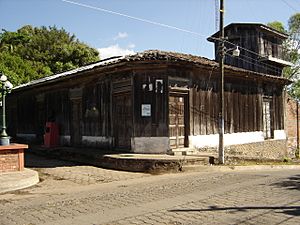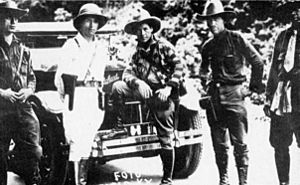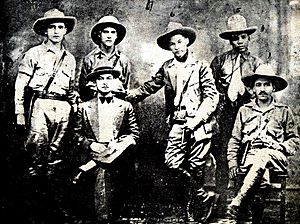Farabundo Martí facts for kids
Quick facts for kids
Farabundo Martí
|
|
|---|---|

Martí in 1929.
|
|
| Born |
Agustín Farabundo Martí Rodríguez
5 May 1893 Teotepeque, El Salvador
|
| Died | 1 February 1932 (aged 38) |
| Cause of death | Execution by firing squad |
| Nationality | Salvadoran |
| Occupation | Revolutionary leader, activist |
| Political party | Communist Party of El Salvador |
| Signature | |
Agustín Farabundo Martí Rodríguez (born May 5, 1893 – died February 1, 1932) was an important activist and leader in El Salvador. He worked for big changes in society, especially during a difficult time known as La Matanza (The Slaughter).
Early Life and Education
Farabundo Martí was born in Teotepeque, a farming town in El Salvador. After finishing high school, he went to the University of El Salvador in San Salvador. From a young age, he saw that many poor people in his country were being treated unfairly. He believed that rich people were benefiting from this unfairness. He became known as a strong voice for change and is seen by many as a hero.
Becoming a Revolutionary
Martí decided to leave his studies at the university to help his community. In 1920, he was arrested for joining a student protest against the powerful family that ruled El Salvador. Because of this, he was sent out of the country. He lived in Guatemala and Mexico before returning to El Salvador in 1925.
After returning, Martí was chosen to go to a big meeting in New York City. This meeting was for a group called the Anti-Imperialist League of the Americas. When he arrived in New York, he was arrested again but later set free. During this time, he also worked with Augusto César Sandino, a famous revolutionary leader from Nicaragua.
Martí helped create the Communist Party of Central America. He also led a group called the International Red Aid, which was like a different kind of Red Cross. This group aimed to help poor people in El Salvador. They believed in a political idea called Marxism-Leninism, which focuses on equality and helping working-class people.
In December 1930, El Salvador was going through a very tough time with money and social problems. Martí was sent out of the country again because he was very popular among the poor. There were even talks that he might run for President the next year.
The Uprising and His Death
In 1931, a new president was elected. Martí came back to El Salvador and, with two friends, Alfonso Luna and Mario Zapata, started a movement. They helped organize a revolt of native farmers who used guerrilla warfare (small groups fighting with surprise attacks). At this time, Martí was a temporary leader of his political party.
The farmers' uprising was led by communists and was fueled by very low coffee prices, which hurt many people. The revolt had some success at first. However, the Salvadoran military quickly stopped it. This happened just ten days after it began. More than 30,000 native people were killed in what was supposed to be a peaceful meeting in 1932. This terrible event became known as "La Matanza" (The Slaughter).
President Maximiliano Hernández Martínez, who had recently taken power from the elected government, ordered Martí to be shot. This happened after a very quick and unfair trial.
See Also
 In Spanish: Agustín Farabundo Martí para niños
In Spanish: Agustín Farabundo Martí para niños
- History of El Salvador
- Politics of El Salvador
- Santa Ana, El Salvador





